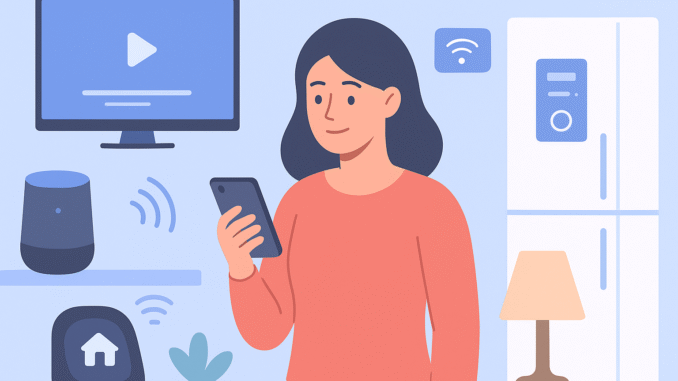
The Rise of Smart Technology: How Innovation Is Changing Everyday Life
Introduction
In just a few decades, technology has transformed from a supporting tool into an inseparable part of daily living. Today, the rise of smart technology is reshaping the way we work, communicate, shop, travel, and even manage our homes. From voice assistants and wearable gadgets to connected cars and smart appliances, innovation is seamlessly blending into our routines, making life more efficient, convenient, and personalized.
This article explores the evolution of smart technology, its impact on everyday life, and what the future holds for this rapidly advancing field.
What Is Smart Technology?
Smart technology refers to devices, systems, or applications that use advanced technologies such as artificial intelligence (AI), machine learning (ML), sensors, and the Internet of Things (IoT) to perform tasks automatically, learn from user behavior, and provide enhanced services.
Unlike traditional devices, smart gadgets are:
- Connected – They communicate with other devices or networks.
- Adaptive – They learn and evolve based on user preferences.
- Efficient – They optimize performance, often saving time, energy, or costs.
Examples range from smartphones, smart speakers, and fitness trackers to smart homes, connected vehicles, and AI-driven healthcare systems.
The Evolution of Smart Technology
The journey of smart tech can be traced through three phases:
- The Early Digital Era (1990s – early 2000s)
- Introduction of mobile phones, personal computers, and the internet.
- Devices were digital but not yet “intelligent.”
- The Connectivity Phase (2000s – 2010s)
- Rise of Wi-Fi, Bluetooth, and cloud computing.
- Smartphones and social media changed how people connected.
- Home automation systems began to appear.
- The Intelligent Era (2010s – Present)
- AI, IoT, and voice assistants like Alexa, Siri, and Google Assistant became mainstream.
- Cars became smarter with GPS, sensors, and self-driving features.
- Health tech evolved with wearables tracking heart rate, sleep, and activity.
How Smart Technology Is Changing Everyday Life
1. Smarter Homes
One of the most visible areas of smart tech innovation is in the home. Devices like smart thermostats, connected lighting, robot vacuum cleaners, and security cameras give homeowners greater control and peace of mind.
- Convenience: Adjusting lights, temperature, or appliances via a smartphone or voice command.
- Energy Efficiency: Smart thermostats reduce electricity bills by learning your habits.
- Security: Doorbell cameras and motion sensors help protect households.
Smart homes are no longer futuristic—they’re becoming the new standard for modern living.
2. Personal Health and Fitness
Health and fitness have been revolutionized by wearable technology. Smartwatches and fitness trackers monitor steps, calories, sleep cycles, and even blood oxygen levels.
- Preventive Care: Early alerts about irregular heart rates or stress levels.
- Motivation: Apps gamify fitness goals, keeping users engaged.
- Healthcare Integration: Doctors can access data from patients’ devices to provide better care.
Smart technology empowers people to take charge of their well-being.
3. Transportation and Mobility
The transportation industry is witnessing a digital revolution.
- Smart Cars: Vehicles equipped with sensors, GPS, and AI can assist drivers or even drive themselves.
- Ride-Sharing Apps: Platforms like Uber and Grab have redefined urban commuting.
- Traffic Management: Smart traffic signals and navigation apps reduce congestion.
- Electric Vehicles (EVs): Often integrated with apps that track battery health and suggest charging stations.
Together, these innovations make travel safer, more efficient, and eco-friendly.
4. Work and Productivity
Remote work and digital collaboration are largely enabled by smart technology.
- Video Conferencing Tools: Platforms like Zoom and Teams connect global teams.
- Cloud Storage: Files can be accessed from anywhere, anytime.
- AI Assistants: Tools like ChatGPT help with drafting content, analyzing data, or automating tasks.
- Smart Offices: IoT-enabled lighting, heating, and scheduling systems improve workplace efficiency.
The smart workplace boosts productivity while offering flexibility for employees.
5. Shopping and Retail
E-commerce and digital payments are transforming how consumers shop.
- Personalized Recommendations: AI suggests products based on browsing history.
- Cashless Payments: Mobile wallets and QR codes speed up checkout.
- Augmented Reality (AR): Customers can “try on” clothes virtually or visualize furniture at home.
- Smart Supply Chains: Real-time tracking ensures faster and more reliable deliveries.
Shopping has become more interactive, efficient, and tailored to individual needs.
6. Entertainment and Lifestyle
From streaming platforms to gaming consoles, smart technology redefines entertainment.
- On-Demand Streaming: Personalized playlists and recommendations.
- Smart TVs: Voice-controlled and internet-connected.
- Virtual Reality (VR) and Augmented Reality (AR): Immersive experiences for gaming, learning, and travel.
Smart entertainment creates endless possibilities for personalized enjoyment.
Benefits of Smart Technology
- Convenience and Time-Saving – Automation reduces repetitive tasks.
- Energy and Cost Efficiency – Optimized systems lower bills and resource usage.
- Better Decision-Making – Data-driven insights guide lifestyle, work, and business choices.
- Improved Health and Safety – Wearables and smart security systems enhance protection.
- Sustainability – Smart grids, EVs, and efficient devices support a greener planet.
Challenges and Concerns
Despite the benefits, smart technology comes with certain challenges:
- Privacy Risks: Devices often collect personal data, raising concerns about misuse.
- Cybersecurity Threats: Hackers can exploit vulnerabilities in connected systems.
- High Costs: Smart gadgets and services can be expensive.
- Digital Divide: Not everyone has equal access to these technologies.
- Overdependence: Too much reliance on technology may reduce human critical thinking.
Balancing innovation with safety and inclusivity is essential for sustainable growth.
The Future of Smart Technology
Looking ahead, smart technology is expected to become even more integrated, intelligent, and human-centered.
- Smarter Cities: IoT will manage waste, energy, and transportation more efficiently.
- AI Integration: Devices will predict needs before users express them.
- Healthcare Innovation: Remote surgeries, AI diagnostics, and advanced wearables will improve healthcare access.
- Green Tech: Eco-friendly smart devices will contribute to global sustainability goals.
- Mixed Reality: The merging of AR and VR into daily life for learning, shopping, and socializing.
The boundary between the physical and digital world will continue to blur, creating a future where technology feels like a natural extension of human life.
Conclusion
The rise of smart technology is not just a trend—it’s a transformation shaping every aspect of modern living. From the way we manage our homes and health to how we work, travel, and enjoy entertainment, innovation is making life more connected, efficient, and personalized.
While challenges like privacy and accessibility remain, the benefits are undeniable. As we move forward, the key lies in embracing smart technology responsibly, ensuring it enhances human life while safeguarding our values and security.
Smart technology is not just changing how we live—it’s redefining what it means to live in the modern world.
